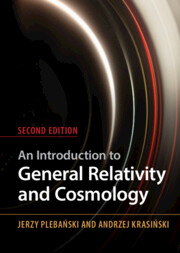Book contents
- Frontmatter
- Contents
- The scope of this text
- Preface to the second edition
- Acknowledgments
- 1 How the theory of relativity came into being (a brief historical sketch)
- Part I Elements of differential geometry
- 2 A short sketch of 2-dimensional differential geometry
- 3 Tensors, tensor densities
- 4 Covariant derivatives
- 5 Parallel transport and geodesic lines
- 6 The curvature of a manifold; at manifolds
- 7 Riemannian geometry
- 8 Symmetries of Riemann spaces, invariance of tensors
- 9 Methods to calculate the curvature quickly: differential forms and algebraic computer programs
- 10 The spatially homogeneous Bianchi-type spacetimes
- 11 * The Petrov classication by the spinor method
- Part II The theory of gravitation
- References
- Index
7 - Riemannian geometry
from Part I - Elements of differential geometry
Published online by Cambridge University Press: 30 May 2024
- Frontmatter
- Contents
- The scope of this text
- Preface to the second edition
- Acknowledgments
- 1 How the theory of relativity came into being (a brief historical sketch)
- Part I Elements of differential geometry
- 2 A short sketch of 2-dimensional differential geometry
- 3 Tensors, tensor densities
- 4 Covariant derivatives
- 5 Parallel transport and geodesic lines
- 6 The curvature of a manifold; at manifolds
- 7 Riemannian geometry
- 8 Symmetries of Riemann spaces, invariance of tensors
- 9 Methods to calculate the curvature quickly: differential forms and algebraic computer programs
- 10 The spatially homogeneous Bianchi-type spacetimes
- 11 * The Petrov classication by the spinor method
- Part II The theory of gravitation
- References
- Index
Summary
The metric tensor and the (pseudo-)Riemannian manifolds are defined. The results of the earlier chapters are specialised to this case, in particular the affine connection coefficients are shown to reduce to the Christoffel symbols. The signature of a metric, the timelike, null and spacelike vectors are defined and the notion of a light cone is introduced. It is shown that in two dimensions the notion of curvature agrees with intuition. It is also shown that geodesic lines extremise the interval (i.e. the ‘distance’). Mappings between Riemann spaces are discussed. Conformal curvature (= the Weyl tensor) is defined and it is shown that zero conformal curvature on a manifold of dimension >=4 implies that the metric is proportional to the flat one. Conformal flatness in three dimensions and the Cotton–York tensor are discussed. Embeddings of Riemannian manifolds in Riemannian manifolds of higher dimension are discussed and the Gauss–Codazzi equations derived. The Petrov classification of conformal curvature tensors in four dimensions with signature (+ - - -) is introduced at an elementary level.
Keywords
Information
- Type
- Chapter
- Information
- An Introduction to General Relativity and Cosmology , pp. 45 - 68Publisher: Cambridge University PressPrint publication year: 2024
